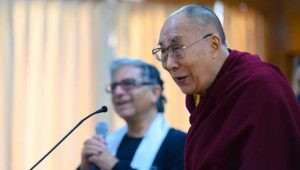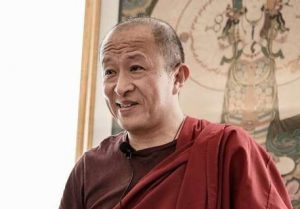
The embassy of Bangladesh in Kathmandu on 6 October signed a formal agreement with the Lumbini Development Trust of Nepal to construct a Bangladeshi Buddhist monastery in Lumbini, the birthplace of the historical Buddha.
The agreement follows a virtual meeting of the Bangladesh cabinet, chaired by Prime Minister Sheikh Hasina in July last year, which approved a draft agreement between the Lumbini Development Trust of Nepal and the government of Bangladesh on the project.* The project was initiated with the personal interest and planning of then Bangladeshi ambassador to Nepal Mashfee Binte Shams, and then first secretary consul Asit Baran Sarkar.
“The Bangladesh Embassy in Nepal said in a statement that the agreement was signed at the headquarters of the Lumbini Development Trust of Nepal in the presence of Bangladesh Ambassador Salahuddin Noman Chowdhury and Lumbini Development Trust vice-chairman Venerable Metteyya Sakyaputta,” Pathik Hasan, a Dhaka-based NGO activist, researcher, and freelance writer with knowledge of the matter, told Buddhistdoor Global on Sunday.

“Project head Saroj Bhattarai and other officials were also present at the signing ceremony on behalf of the Lumbini Development Trust, while the first secretary, Alamgir Islam Khan, was present on behalf of the embassy,” Hasan added.
Cabinet-secretary Khandaker Anwarul Islam noted last year that the Lumbini Development Trust had agreed and approved all activities, including design, through Bangladesh’s Ministry of External Affairs, with an estimated construction cost of 512 million Bangladeshi taka (US$6 million). He added that since it was an agreement with another country, the matter had come before the cabinet for approval.*
“According to the agreement, the Lumbini Development Trust will allot the plot and the government of Bangladesh will bear all expenses for the construction of the Buddhist monastery on that allotted plot,” Hasan told Buddhistdoor Global.
Located in Rupandehi District of Nepal’s Province No.5, Lumbini is one of the most important spiritual sites in the world for Buddhist pilgrims. Lumbini is home to a number of old temples, the most sacred among them being Maya Devi Temple, marking the site that archaeologists have identified as where Shakyamuni Buddha was most likely born. Inscriptions on the nearby pillar of Ashoka also refer to the spot as the Buddha’s birthplace. In 1997, Lumbini was officially listed as a UNESCO World Heritage Site.
In recent years, the Bangladeshi government has launched a number of projects to showcase the country’s Buddhist legacy. In 2015, in collaboration with United Nations World Tourism Organization (UNWTO), Bangladesh for the first time hosted an international conference titled “Developing Sustainable and Inclusive Buddhist Heritage and Pilgrimage Circuits in South Asia’s Buddhist Heartland” in Dhaka. The event was an open dialogue for sustainable development and the promotion of cross-border tourism circuits and routes in South Asia and the Asia-Pacific region.
* Bangladesh to Build Buddhist Monastery in Lumbini, Nepal (Buddhistdoor Global)
See more
Agreement of Bangladesh monastery (YouTube)
Agreement of Bangladesh monastery in Lumbini 2 (YouTube)
Agreement of Bangladesh monastery in Lumbini 3 (YouTube)
Related news reports from Buddhistdoor Global
Bangladesh to Conduct Funeral Rites for Buddhist Supreme Patriarch Ven. Dharmasen Mahathera
Minorities in Bangladesh Protest against Oppression across the Country
Rakhine Community in Bangladesh Protests Myanmar’s Military Aggression in Rakhine State
Air Pollution Levels Threaten Birthplace of the Buddha
Ancient Buddhist Monastery Complex Discovered in Bangladesh
Gautam Buddha International Airport Due to Open Near Lumbini, Nepal, in Mid-2020
Buddhist and Muslim Leaders Meet in Bangladesh to Reaffirm Humanitarian Commitments
Related features from Buddhistdoor Global
The Untapped Diplomatic Potential of Bangladesh’s Buddhist Heritage
Pakistan, Sri Lanka, and Nepal: A New Bloc of Buddhist Communication?
The Xuanzang Memorial: Evoking China and India’s Buddhist Past and Future
Buddhist Tourism in West Bengal and Bangladesh: An Untapped Resource












